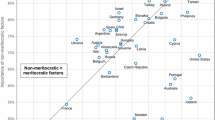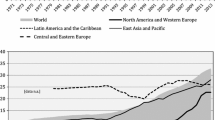Abstract
After much attention during its development, the continued importance of the Western Governors University (WGU) has not been significantly addressed since it opened in 1998. While certainly not dominating the higher education environment as predicted by its founders, it has nonetheless demonstrated a new competency-based distance education model for higher education. For that reason, the implications of WGU should be taken seriously. Three potential implications for colleges and universities are outlined: accreditation policies, organizational models, and faculty roles. While its survival as an institution is questionable, the concepts behind WGU remain important in changes in American higher education.
Similar content being viewed by others
References
Ashworth, K. H. (1996, September 6). Virtual universities could only produce virtual learning. Chronicle of Higher Education, p. A88.
Bess, J. L., and Associates. (2000). Teaching alone, teaching together: Transforming the structure of teams for teaching. San Francisco: Jossey Bass.
Blumenstyk, G. (1995, December 15). 11 Western governors to study creation of “virtual university”. Chronicle of Higher Education. p. A19.
Blumenstyk, G. (1998, February 6). Western Governors U. takes shape as a new model for higher education.Chronicle of Higher Education. p. A21.
Carr, S. (2000, January 14). Enrollment growth remains slow at Western Governors U. Chronicle of Higher Education. p. A49.
Council of Regional Accrediting Commissions. (1999, September 27). Proposed policies on the accreditation of institutions operating interregionally. [On-line]. Accessed: March 16, 2001. http://www.ncahigherlearningcommission.org/resources/irpcrac.html
Council of Regional Accrediting Commissions. (2001). Statement of commitment by the Regional Accrediting Commissions for the evaluation of electronically offered degree and certificate programs. [on-line]. Accessed: March 16, 2001. http://www.wiche.edu/ telecom/Article1.htm
Cuban, L. (1999). How scholars trumped teachers: Change without reform in university curriculum, teaching and research, 1890–1990. New York: Teachers College Press.
Inter-Regional Accreditation Committee. (1998, July). Interregional eligibility requirements and standards for accreditation. Bellevue, WA: Northwest Association of Schools and Colleges Commission on Colleges.
Johnstone, S. M., & Tilson, S. (1997). Implications of a virtual university for community colleges. In C. L. Dillon & R. Cintron. (Eds.), Building a working policy for distance education (pp. 63–72). New Directions for Community Colleges, no. 99. San Francisco: Jossey-Bass.
Kinser, K. (1999). Origin, development, and implications of theWestern Governors University. Unpublished Dissertation, Columbia University, Teachers College, New York.
Lazerson, M., Wagener, U., & Shumanis, N. (2000). What Makes a Revolution? Change, (May/June). 12–19.
Leavitt, M. O. (1996). Virtual U. Multiversity (Winter), 12–15.
Livingston, J., & Albrecht, B. (1996, October 3). Accreditation issues for the Western Governors University [Memorandum]. Denver: Western Governors University.
Marchese, T. (1998). Not-so-distant competitors: How new providers are remaking the postsecondary marketplace. AAHE Bulletin, 50(8), 3–7.
Noble, D. F. (1998). Digital diploma mills: The automation of higher education. First Monday, 3(1). [on-line] Accessed: March 16, 2001. http://www.firstmonday.dk/ issues/issue3 1/noble/index.html
O'Banion, T. (1997). A learning college for the 21st century. Phoenix: Oryx Press
Regional Accreditation Committee. (1996, January). Eligibility requirements and accreditation standards: Report of the Regional Accreditation Committee [Document]. Washington, DC: Author.
Rudolph, F. (1993). Curriculum: A history of the undergraduate course of study. San Francisco: Jossey-Bass.
Stuart, A. (1998, September 1). Beyond the Campus. CIOWeb Business, Section 2, pp. 30–40.
Wellman, Jane V. (2000, September 22). Accreditors have to see past “learning outcomes”. The Chronicle of Higher Education. p. B20.
Western Governors Association. (1995, November 30–December 1). Higher education and technology leadership meeting [Audio Tape]. Las Vegas: Las Vegas Audio Taping.
Western Governors Association. (1996). From vision to reality: A western virtual university. Denver: Author.
Western Governors University. (1996, October). TheWestern Governors University: Implementation plan progress report and update [Memorandum]. Salt Lake City: Author.
Western Governors University. (2000, November 27). Western Governors University First competency-based university to achieve candidacy for accreditation. [Press Release]. Salt Lake City: Author.
Western Governors University. (2001a). Home page of the Western Governors University. [on-line]. Accessed: March 16, 2001. http://www.wgu.edu
Western Governors University. (2001b, February 23). Western Governors University reports great progress. [Press Release]. Salt Lake City, UT: Author.
Young, J. R. (1999, May 7). A virtual student teaches himself. Chronicle of Higher Education. p. A31.
Author information
Authors and Affiliations
Rights and permissions
About this article
Cite this article
Kinser, K. Taking WGU Seriously: Implications of the Western Governors University. Innovative Higher Education 26, 161–173 (2002). https://doi.org/10.1023/A:1017964805356
Issue Date:
DOI: https://doi.org/10.1023/A:1017964805356




